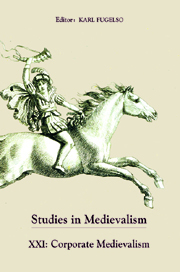Book contents
- Frontmatter
- Acknowledgments
- Contents
- Title in the Series
- Editorial Note
- I Corporate Medievalism: Some Perspective(s)
- II Interpretations
- Historicizing Neumatic Notation: Medieval Neumes as Cultural Artifacts of Early Modern Times
- Hereward the Dane and the English, But Not the Saxon: Kingsley's Racial Anglo-Saxonism
- From Romance to Ritual: Jessie L. Weston's Gawain
- The Cinematic Sign of the Grail
- Destructive Dominae: Women and Vengeance in Medievalist Films
- III Response
- Notes on Contributors
- Title in the Series
The Cinematic Sign of the Grail
from II - Interpretations
Published online by Cambridge University Press: 05 February 2013
- Frontmatter
- Acknowledgments
- Contents
- Title in the Series
- Editorial Note
- I Corporate Medievalism: Some Perspective(s)
- II Interpretations
- Historicizing Neumatic Notation: Medieval Neumes as Cultural Artifacts of Early Modern Times
- Hereward the Dane and the English, But Not the Saxon: Kingsley's Racial Anglo-Saxonism
- From Romance to Ritual: Jessie L. Weston's Gawain
- The Cinematic Sign of the Grail
- Destructive Dominae: Women and Vengeance in Medievalist Films
- III Response
- Notes on Contributors
- Title in the Series
Summary
Introduction
One of the greatest challenges in modernizing medieval romances has been to represent the elusive image of the grail in film. From the earliest narratives the grail has been open to multiple significations. Thus, its Christian significance, which eventually turned it into the legendary Holy Grail, is not self-evident in the earliest surviving accounts, such as Chrétien de Troyes' Le Conte du Graal or the anonymous Peredur from Wales. In those narratives it took different forms, ranging from a severed head or a stone, to a dish or a chalice, so that “the history of both the representation and identification of the Grail was far less iconic than our contemporary perception of it.” Modern cinema inherited the grail story heavily marked by the Christian legend of Joseph of Arimathea, which originated in Robert de Boron's thirteenth-century text Joseph, was vastly developed in the Arthurian Vulgate cycle, and was consecrated within English culture by Thomas Malory. While a new focus on the iconic nature of the grail appears in nineteenth-century painting, the story itself underwent no essential transformation until it reached the silver screen, which makes the grail a privileged motif for a case study of medievalism in cinema. Ultimately drawing on Peircean semiotics, I propose to trace the ways in which various movies have adapted the medieval symbol to their own iconic purposes, or failed significantly to do so.
- Type
- Chapter
- Information
- Studies in Medievalism XXICorporate Medievalism, pp. 145 - 160Publisher: Boydell & BrewerPrint publication year: 2012

